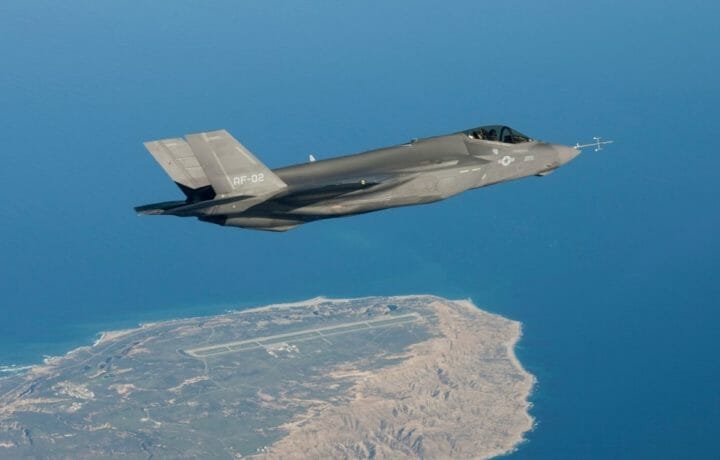The F-35 Lightning II is arguably the most advanced fighter aircraft ever built, but it has not been without its share of controversy. It is one of the most expensive combat planes ever developed, and is also expensive to operate, making lawmakers ponder whether or not the fifth-generation warbird is the right plane to address threats from near peer adversaries including China and Russia.
Three variants were developed via the F-35 Joint Strike Fighter program, including the F-35A, a conventional takeoff and landing version; the F-35B, a short takeoff and vertical landing (STOVL) model; and the F-35C, a carrier-based version that features larger wings and fuel tank. The United States Air Force operates the F-35A, while the U.S. Navy operates the F-35C, with the United States Marine Corps operating both the F-35B and C models.
Some 13 partner nations operate various models of the F-35, while Israel even has a specifically modified version, the F-35I “Adir,” which features unique avionics that were developed in the Middle Eastern nation.
Lightning Strikes Lightning
Supporters of F-35 have argued that while costly, the platform remains the most advanced combat aircraft in the world and that it is unrivaled in the air. However, despite being touted as an “all-weather” fighter, the F-35 Lightning II has an “Achilles Heel” – actual lightning.
Earlier this month, two F-35Bs based out of Marine Corps Air Station Iwakuni, Japan suffered serious damage after being struck by lightning while in flight. Both aircraft were able to land safely and no Marines were injured in the incident, the Marine Corps said in a statement.
However, the lightning strike, which occurred on July 14, caused enough damage to each of the fighter planes that both strikes were classified as a “Class A mishap.” Such mishaps are defined as incidents that resulted in either death or permanent disability, or more than $2.5 million in damages.
“After conducting our standard reporting and assessment procedures, the weather-related incident was labeled as a class ‘A’ mishap due to the combined projected repair costs exceeding two and a half million U.S. dollars,” Capt. Marco A. Valenzuela, a spokesman for Marine Air Group 12, told Marine Corps Times via an email. “We are currently conducting an investigation into the mishap and will incorporate the lessons learned into future flight operations.”
OBIGGS is a Big Problem
This is not the first time that lightning has been an issue with the F-35 Lightning II, and thunderstorms have caused the F-35A variants to be grounded. That is because of problems with the aircraft’s onboard inert gas generation system (OBIGGS), which pumps nitrogen-enriched air into the plane’s fuel system, rendering it inert and preventing the fuel from igniting if struck by lightning.
The F-35 has suffered issues with the OBIGGS for many years, and deficiencies with the system that is supposed to pump the nitrogen-enriched air into the fuel tanks were first discovered during tests in 2008. The tests revealed a serious design fault where the F-35 could even explode if struck by lightning—which is somewhat ironic given that the aircraft’s name is Lightning II.
For those reasons the aircraft had been restricted from flying within 25 miles of lightning conditions. The issue had been resolved in 2014, but then additional faults were discovered—and that prompted the grounding of the Royal Netherlands Air Force’s F-35As during last year’s Allied Sky operations in Europe.
Lightning flight restrictions have remained in place since June of last year.
OBIGGS Variant
The F-35B variant has a modified version of the OBIGGS system, and it fits around the lift fan – which enables the short take off and vertical landing – and that has largely made it immune to the lightning issues of the F-35A model.
However, as noted by this month’s lightning strike of the USMC aircraft, summer thunderstorms can still be a serious problem to the expensive all-weather aircraft.
Lightning vs. Lightning
The U.S. military hasn’t tried to shy away from the problem, and has continued to seek ways to protect the aircraft from lightning strikes, including when the aircraft are parked on the ground and could be at risk during a thunderstorm.
Just this week, the official social media account of Nellis Air Force Base (@NellisAFB) posted a photo of a pair of F-35As parked on the flight line with lightning rods to protect the aircraft, with lightning in the background. The caption read, “Which lightning do you think strikes harder?”
The two aircraft were from Hill AFB in Utah, home to the 388th and 419th Fighter Wings, both of which are equipped with Joint Strike Fighters. The jets are at Nellis, which is situated on the outskirts of Las Vegas, Nevada, taking part in the Red Flag 21-3 exercise, which began on July 19 and runs through Aug. 6, The Drive reported.




